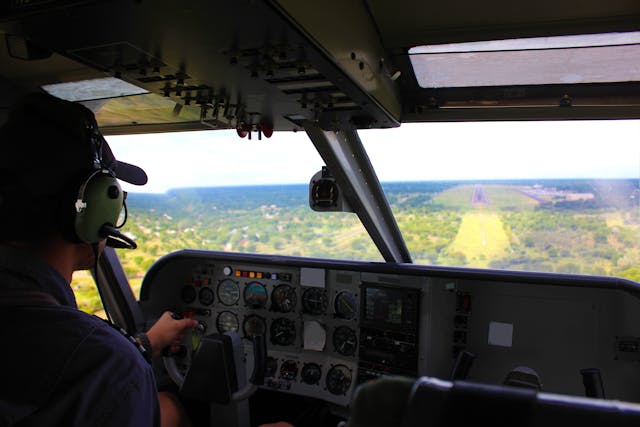- Urban airspace technologies offer a solution for efficient, innovative city mobility, pending regulatory and infrastructural challenges.
- Personal aircraft could revolutionize urban transport, reducing congestion and fostering economic growth through new industry sectors.
- Implementation requires collaboration among technologists, policymakers, and planners to overcome technical, regulatory, and social hurdles.
- The potential of urban airspace transcends science fiction, promising a sustainable, inclusive future with eVTOL technology at the core of city life.
- Realizing this vision necessitates carefully balancing innovation and inclusivity, ensuring equitable access to emerging transport options.
In the age of innovation, how we move within our cities is experiencing a revolution. Traditional ground-based transportation systems, such as cars and public mass transit, are feeling the pressure of growing urban populations and are increasingly becoming a source of frustration rather than convenience. In this context, the concept of ‘airspace mobility’ and the technological promise of personalized aircraft have started to gain traction in discussions about the future of urban living.
Historically, urban mobility has been closely linked to societal progress. The invention and proliferation of the automobile shaped not just our cities’ skylines but the fabric of how we interact and live. However, with nearly two-thirds of the world’s population expected to live in cities by 2050, current transportation systems will soon reach their breaking point.
This post explores urban airspace and personal aircraft, exploring their potential to transform the way we move in urban environments, the challenges we must overcome, and the vision for a future where the sky truly is the limit.
Evolution of Urban Mobility
Evolutionary milestones have marked the transportation landscape within cities. From the horse-drawn carriages and trams of the 19th century to the mass production of automobiles in the 20th century, we have seen a steady progression towards increasing personal mobility and speed. This evolution has reflected the technological capabilities of each era, as well as urbanites’ changing needs and desires.
Ground-to-Air Transition
The transition from horse-drawn carriages to the first motor vehicles marked a significant leap in speed and efficiency. This transformation catalyzed economic growth and had profound implications for individual freedom and social connectivity.
The current discussions around urban airspace and personal aircraft can be seen as a continuation of this trend. In many ways, personal aircraft available to the public represents an offering that combines the efficiency of flying with the autonomy and convenience of a car.
The Technological Push
Technological advancements, particularly in electric and autonomous flight, make personal aircraft more feasible. With silent, electric vertical takeoff and landing (eVTOL) vehicles, the skies above our cities are poised to become new highways that can significantly reduce travel times in densely populated areas.
However, this envisioned future necessitates a thoughtful approach to integration and sustainability, considering the infrastructure, regulations, and environmental impacts of this new mode of transportation.
Challenges in Implementing Airspace Mobility
Regulatory Hurdles
One of the most significant challenges in adopting personal aircraft for urban mobility is establishing a regulatory framework that ensures safety and navigational clarity. The existing framework was designed for commercial aviation and may not easily adapt to the new, decentralized model of urban air mobility.
Policy makers and aviation authorities worldwide are currently grappling with the task of creating rules that allow for the safe operation of potentially thousands of small, low-altitude aircraft in urban areas.
Infrastructure Requirements
Envisioning a future with personal aircraft requires us to think about urban infrastructure in a completely new way. Landing pads, takeoff zones, and charging stations must be integrated into city design plans.

Current discussions focus on repurposing existing infrastructure, such as parking lots and urban rooftops, to accommodate these needs. Additionally, new construction may become necessary, raising questions about land use, engineering, and urban planning practices.
Environmental Considerations
The environmental implications of opening urban airspace to personal aircraft are complex. On one hand, electric and hybrid technologies are poised to significantly reduce overall emissions in urban transportation. On the other hand, the potential increase in air traffic could reintroduce issues of noise pollution and, in dense areas, challenges related to air quality.
Sustainable practices, including the design of ultra-efficient aircraft and the embedding of green technologies into urban air infrastructure, will be critical to ensuring that negative environmental impacts do not outweigh the benefits of urban air mobility.
The Role of Personal Aircraft in Future Urban Mobility
Technological Advancements
Recent breakthroughs in battery technology and design have led to the creation of efficient, electrically powered aircraft capable of short-range urban flights. Companies like Volocopter and Joby Aviation are spearheading the development of eVTOL aircraft that are eco-friendly and design-conscious, seamlessly blending into the urban landscape.
Furthermore, the potential for autonomous flight technology to be incorporated into these vehicles could significantly democratize air travel, making use of personal aircraft as simple as hailing a ride-sharing service.
Accessibility and Pilot Training
For personal aircraft to meaningfully impact urban mobility, they must be accessible to a wide range of individuals. This accessibility includes the usability of the vehicles themselves and the affordability of using such services.
Pilot training will also be a critical aspect of this transition. While certain eVTOL aircraft are being designed for operation by non-pilot passengers, a world with significant aerial traffic will likely require a sizeable pool of trained pilots to ensure safety and manage logistics accurately.
Acquiring a private pilot license marks a significant milestone in personal aviation, offering a tangible testament to an individual’s dedication, skill, and passion for flying. This credential not only opens the doors to the skies, allowing pilots the freedom to explore the world from a breathtaking new perspective, but it also signifies a level of competence and trustworthiness in the aviation community.

With such a license, individuals gain the flexibility to pilot aircraft for personal and recreational purposes, providing unparalleled opportunities for travel, adventure, and personal growth. Furthermore, earning this license equips pilots with a deep understanding of aerial navigation, weather considerations, and aircraft mechanics, enhancing their ability to contribute meaningfully to the future evolution of urban air mobility.
Economic Implications
The adoption of personal aircraft in urban areas could have far-reaching economic implications. Reducing travel times would lead to more efficient commerce and would likely stimulate the growth of new industries and job opportunities related to urban airspace technologies.
Investments in developing and implementing these technologies could also lead to substantial economic growth, provided that they do not exacerbate inequalities in access to transportation.
Conclusion
The future of urban mobility is a vast, open sky waiting to be explored. Personal aircraft and associated urban airspace technologies offer a compelling vision for more efficient, connected, and dynamic cities. However, realizing this vision will require concerted efforts from technologists, policymakers, and urban planners to tackle the multifaceted challenges ahead.
From reimagining cityscapes to rewriting air traffic regulations, the task at hand is as complex as it is exciting. Yet, for a world on the brink of urban expansion, the potential benefits of urban airspace technologies make them more than a mere flight of fancy—they are critical elements for forging a sustainable and inclusive urban future.
The promise of personal aircraft and an opened urban airspace is not mere science fiction but a tangible reality on the horizon. Just as the automobile transformed our cities in the 20th century, integrating air travel into urban life will redefine what it means to live, work, and play in the 21st century. In this vision, the noiseless hum of eVTOL engines may well become the heartbeat of a new, airborne urban ecosystem.




